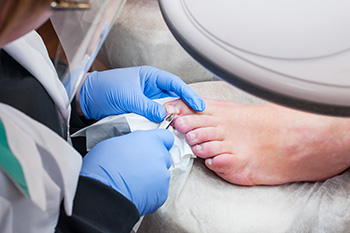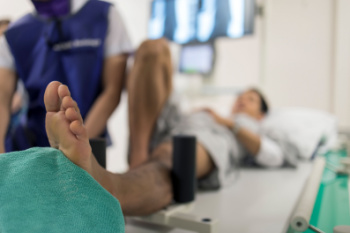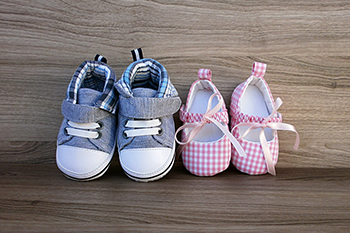January 2025
Do You Suffer From Painful Feet?
Surgery for an Ingrown Toenail

An ingrown toenail occurs when the edge of a toenail grows into the surrounding skin causing pain, redness, swelling, and sometimes infection. This condition is most common on the big toe and can occur from improper nail trimming, wearing tight shoes, or injury to the toe. When conservative treatments such as soaking, proper nail care, and antibiotics for infection do not provide relief, ingrown toenail surgery may be necessary. A podiatrist numbs the toe with a local anesthetic during the procedure to ensure comfort. This is followed by carefully removing the portion of the nail that is growing into the skin. In more severe cases, part of the nail bed may also be removed to prevent the nail from growing back into the skin. The area is cleaned and a dressing is applied. With proper care and hygiene, recovery typically takes a few weeks to ensure a successful healing process. If you have an ingrown toenail, it is suggested that you contact a podiatrist who can provide the best treatment solutions which may include surgery.
Ingrown toenails can become painful if they are not treated properly. For more information about ingrown toenails, contact Gregory Rorick, DPM of Rorick Podiatry, PC. Our doctor can provide the care you need to keep you pain-free and on your feet.
Ingrown Toenails
Ingrown toenails occur when a toenail grows sideways into the bed of the nail, causing pain, swelling, and possibly infection.
Causes
- Bacterial infections
- Improper nail cutting such as cutting it too short or not straight across
- Trauma to the toe, such as stubbing, which causes the nail to grow back irregularly
- Ill-fitting shoes that bunch the toes too close together
- Genetic predisposition
Prevention
Because ingrown toenails are not something found outside of shoe-wearing cultures, going barefoot as often as possible will decrease the likeliness of developing ingrown toenails. Wearing proper fitting shoes and using proper cutting techniques will also help decrease your risk of developing ingrown toenails.
Treatment
Ingrown toenails are a very treatable foot condition. In minor cases, soaking the affected area in salt or antibacterial soaps will not only help with the ingrown nail itself, but also help prevent any infections from occurring. In more severe cases, surgery is an option. In either case, speaking to your podiatrist about this condition will help you get a better understanding of specific treatment options that are right for you.
If you have any questions please feel free to contact our office located in New York Mills, Utica, NY . We offer the newest diagnostic and treatment technologies for all your foot and ankle needs.
Main Causes of Pickleball Injuries

The rising popularity of pickleball has resulted in an increase in foot and ankle injuries, particularly among older adults. Quick, repetitive movements such as lunging, running, and sudden foot planting can lead to common injuries like Achilles tendon ruptures, ankle sprains, and fractures. Achilles tendon ruptures are especially prevalent, often requiring immediate medical intervention to restore mobility. Ankle sprains frequently occur when the foot twists or inverts, causing pain, swelling, and instability. Many pickleball injuries are linked to insufficient warm-ups, wearing improper footwear, or the physical demands of the sport, especially on players who may already have underlying foot or ankle issues. A podiatrist can assess these injuries, provide an accurate diagnosis, and determine the best course of treatment. This may include immobilization, bracing, or, in some cases, surgery to ensure a safe recovery and prevent future complications. If you have sustained a foot or ankle injury from playing pickleball, it is suggested that you schedule an appointment with a podiatrist for an exam and treatment.
Ankle and foot injuries are common among athletes and in many sports. They can be caused by several problems and may be potentially serious. If you are feeling pain or think you were injured in a sporting event or when exercising, consult with Gregory Rorick, DPM from Rorick Podiatry, PC. Our doctor will assess your condition and provide you with quality foot and ankle treatment.
Common Injuries
The most common injuries that occur in sporting activities include:
- Achilles Tendonitis
- Achilles Tendon Rupture
- Ankle Sprains
- Broken Foot
- Plantar Fasciitis
- Stress Fractures
- Turf Toe
Symptoms
Symptoms vary depending upon the injury and in some cases, there may be no symptoms at all. However, in most cases, some form of symptom is experienced. Pain, aching, burning, bruising, tenderness, tightness or stiffness, sensation loss, difficulty moving, and swelling are the most common symptoms.
Treatment
Just as symptoms vary depending upon the injury, so do treatment options. A common treatment method is known as the RICE method. This method involves rest, applying ice, compression and elevating the afflicted foot or ankle. If the injury appears to be more serious, surgery might be required, such as arthroscopic or reconstructive surgery. Lastly, rehabilitation or therapy might be needed to gain full functionality in the afflicted area. Any discomfort experienced by an athlete must be evaluated by a licensed, reputable medical professional.
If you have any questions, please feel free to contact our office located in New York Mills, Utica, NY . We offer the newest diagnostic and treatment technologies for all your foot care needs.
Causes of Foot Stress Fractures

A foot stress fracture is a small crack or break in a bone caused by repetitive force or overuse. This type of fracture often occurs in athletes, particularly runners, and people who engage in high-impact activities. The primary cause of a stress fracture is the accumulation of stress on the bone leading to tiny cracks. Common symptoms include localized pain, swelling, and tenderness, particularly during activity or when pressure is applied to the affected area. Finding relief from a stress fracture typically involves rest, avoiding weight-bearing activities, and elevating the foot to reduce swelling. A podiatrist may recommend wearing a walking boot or using crutches to minimize stress on the foot. If you have developed a foot stress fracture, it is suggested that you consult a podiatrist who can accurately diagnose and effectively treat a foot stress fracture.
Activities where too much pressure is put on the feet can cause stress fractures. To learn more, contact Gregory Rorick, DPM from Rorick Podiatry, PC. Our doctor can provide the care you need to keep your pain free and on your feet.
Dealing with Stress Fractures of the Foot and Ankle
Stress fractures occur in the foot and ankle when muscles in these areas weaken from too much or too little use. The feet and ankles then lose support when walking or running from the impact of the ground. Since there is no protection, the bones receive the full impact of each step. Stress on the feet can cause cracks to form in the bones, thus creating stress fractures.
What Are Stress Fractures?
Stress fractures occur frequently in individuals whose daily activities cause great impact on the feet and ankles. Stress factors are most common among:
- Runners
- People affected with Osteoporosis
- Tennis or basketball players
- Gymnasts
- High impact workouts
Symptoms
Pain from the fractures occur in the area of the fractures and can be constant or intermittent. It will often cause sharp or dull pain with swelling and tenderness. Engaging in any kind of activity which involves high impact will aggravate pain.
If you have any questions please feel free to contact our office located in New York Mills, Utica, NY . We offer the newest diagnostic and treatment technologies for all your foot and ankle needs.
Choosing Baby's 1st Walking Shoes

First walking shoes are an important milestone in a baby's development, offering both support and comfort as they take their first steps. There are several types of first walking shoes designed to meet the needs of growing feet. Soft-soled shoes are ideal for early walkers as they provide flexibility while offering protection against rough surfaces. These shoes allow babies to feel the ground, which helps with balance and coordination. Hard-soled shoes are better suited for toddlers who are more confident walkers, offering stability and durability for outdoor adventures. Another option is sandals with secure straps, which provide breathability and comfort during warmer months. It is essential to choose shoes that fit properly and have enough room for the toes to move freely. If your child has trouble walking or has foot pain, it is suggested that you contact a podiatrist who can monitor your baby’s foot health, and guide you on helpful tips for choosing the right shoes.
The health of a child’s feet is vital to their overall well-being. If you have any questions regarding foot health, contact Gregory Rorick, DPM of Rorick Podiatry, PC. Our doctor can provide the care you need to keep you pain-free and on your feet.
Tips for Keeping Children's Feet Healthy
- Make sure their shoes fit properly
- Look for any signs of in-toeing or out-toeing
- Check to see if they have Clubfoot (condition that affects your child’s foot and ankle, twisting the heel and toes inward) which is one of the most common nonmajor birth defects.
- Lightly cover your baby’s feet (Tight covers may keep your baby from moving their feet freely, and could prevent normal development)
- Allow your toddler to go shoeless (Shoes can be restricting for a young child’s foot)
- Cut toenails straight across to avoid ingrown toenails
- Keep your child’s foot clean and dry
- Cover cuts and scrapes. Wash any scratches with soap and water and cover them with a bandage until they’ve healed.
If you have any questions, please feel free to contact our office located in New York Mills, Utica, NY . We offer the newest diagnostic and treatment technologies for all your foot care needs.











